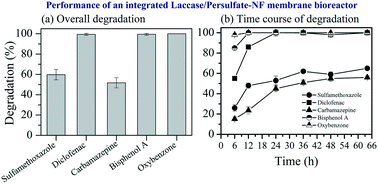Elucidating the performance of an integrated laccase- and persulfate-assisted process for degradation of trace organic contaminants (TrOCs)
Abstract
Laccase-catalysed degradation is a promising technology for the degradation of trace organic contaminants (TrOCs). However, depending on their physicochemical properties (e.g., chemical structures), non-phenolic TrOCs appear to be resistant to laccase-catalysed degradation, thus requiring an additional treatment process. In this study, the performance of an integrated laccase and persulfate (PS) mediated oxidation process was explored and elucidated for the first time. Compared to that achieved during treatment with laccase alone, the addition of PS at 1–10 mM concentration into batch enzymatic bioreactors showed concentration-dependent improvement in the degradation of the five TrOCs selected, namely diclofenac, sulfamethoxazole, carbamazepine, bisphenol A and oxybenzone. The results obtained from a series of batch tests also confirmed that the structural components (e.g., carbohydrate moieties in the enzyme) as well as the possibility of PS acting as a final acceptor of electrons from the type II and type III active sites of laccase may have led to PS activation. A continuous treatment system was developed by integrating a nanofiltration (NF) membrane with the laccase/PS process (NF-MBRlaccase/PS), which achieved TrOC-specific degradation. Importantly, the degradation of non-phenolic TrOCs (diclofenac, sulfamethoxazole and carbamazepine) further improved by 10 to 65% in the NF-MBRlaccase/PS system. This improvement could be attributed to: (i) the prolonged contact time between laccase/PS and TrOCs, which was possible due to their complete retention by the NF membrane; and (ii) retention of oxidative cross coupling agents or secondary radicals enhancing TrOC degradation. The NF membrane not only retained the moderately degraded carbamazepine and sulfamethoxazole effectively but also effectively removed toxic transformation products and residual estrogenicity of the final effluent as evaluated by cytotoxicity and estrogenicity assays, respectively. These observations indicate the significance of the high retention membrane in the NF-MBRlaccase/PS system for producing high quality permeate suitable for disposal and potentially for water reuse applications.



 Please wait while we load your content...
Please wait while we load your content...